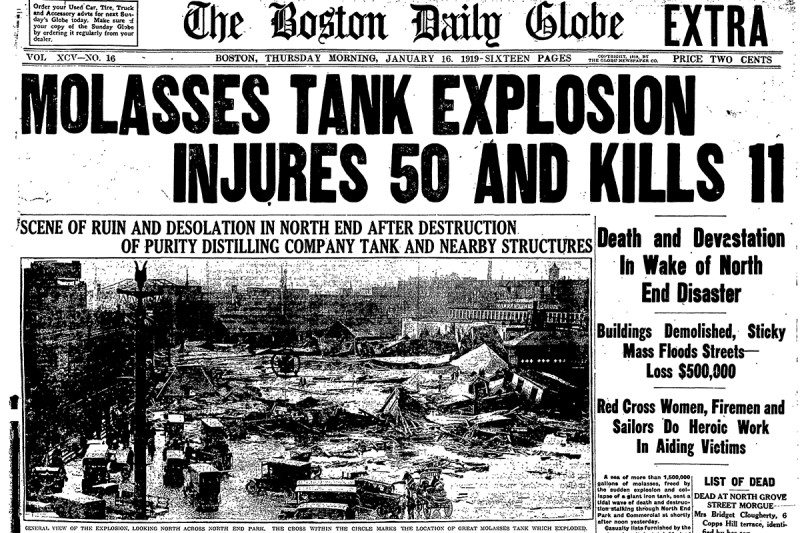 |
| The cover of the Boston Daily Globe, January 16, 1919, detailing the disaster. |
How slow is molasses in January? Not as slow as you might think. On January 15, 1919, it was estimated to have moved about 35 miles per hour. That was the day a large tank containing molasses, 50 feet tall and 90 feet around, burst in Boston’s North End, spilling molasses across Commercial Street and beyond.
January 15 was an unusually warm day, hitting about 40º F, following a cold snap. The rapid warming likely built up pressure that compromised the integrity of the tank. Rivets popped out of the side of the tank at the Purity Distilling Company as the wall began to collapse, unleashing over 2 million gallons of molasses. A wave of molasses 25 feet high rushed out, knocking small buildings off their foundations, damaging the girders of the overhead railroad, and flooding several blocks with anywhere from two to three feet. 21 people were drowned in the molasses, along with a number of horses. Others were knocked out of the way by the air displaced by the wall of molasses. In all, 150 people were injured.
To the rescue came the Boston Police, the Red Cross, the Army, and cadets from the Massachusetts Nautical School, keeping rubberneckers at bay and wading into the goo to pull survivors out. In order to clean up the mess, crews dumped sand and salt water on it and it was pushed into Boston Harbor. All summer the harbor was brown and sweet-smelling. Well into the 1920s, the local rat population flourished. Residents claimed for decades after that they could still smell the molasses in the area.
The owners of Purity Distilling, the United States Industrial Alcohol Company, insisted that “anarchists” had blown up the tank, and that they weren’t at fault. The courts found otherwise, and after three years of litigation, families were awarded $7,000 per victim. It was the first successful class-action lawsuit ever brought before a court in Massachusetts. In total, the company paid out $600,000 in damages. A later inquiry found that the construction company that built the tank made it half as thick as it ought to have been for the purpose it was used for, and that they never did even the most basic safety tasks. This resulted in a flood of laws requiring that Boston industrial sites conduct such tests in the future.
| The aftermath of the burst tank. |


Comments